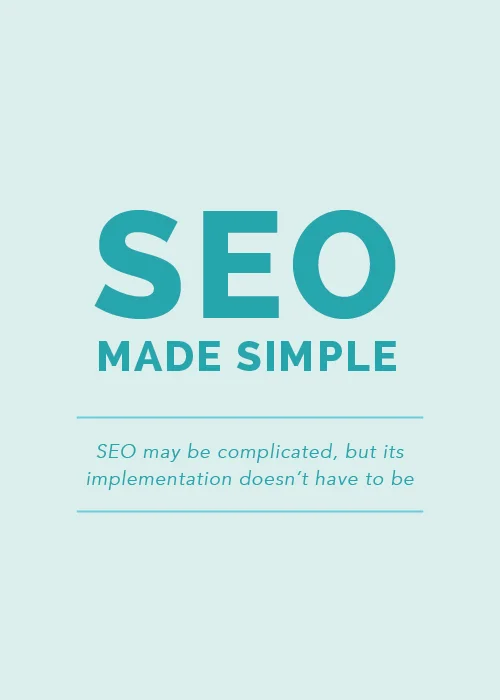If you ask 100 people about SEO, you might get 100 different answers. And frankly, it all depends on what you're trying to accomplish through your blog or website. We can relate to the uphill battle of trying to get your content in front of countless people through search engines, so today Jake and I are partnering together to share how you can create content that will rank higher in search engine results.
If you haven't read Elle & Company's SEO Made Simple article, that might be a helpful read before you dive into this one!
Focus on long-tail keywords in your blog post title
The days of stuffing your site full of certain keywords in order to increase your pagerank are long gone. In fact, it can get your website penalized. Google says,
"'Keyword stuffing' refers to the practice of loading a website with keywords or numbers in an attempt to manipulate a site's ranking in Google search results. Often these keywords appear in a list or group, or out of context (not as natural prose). Filling pages with keywords or numbers results in a negative user experience, and can harm your site's ranking." (source)
If you're trying to pack your site full of words that have no context to the rest of your content, it will be penalized. Instead, it's best to focus on writing prose and integrating words or phrases organically.
Long-tail keywords within your blog post title are a way to overcome this problem. A long-tail keyword is a specific phrase searched by a search engine user. For example, a person would probably search for "black Nike basketball shorts" instead of searching for simply, "shorts." People tend to have a pretty good idea of what they're looking for before they search for something in Google, and it's usually something fairly specific. In fact, 70% of all search engine requests are long-tail keyword searches (source).
Not only are titles an important factor in SEO, but if you're like us, you create the blog title before you begin fleshing out the post. Not only is it helpful to have a solid idea of what you're writing about at the outset, but you're more likely to include that same phrase or group of words throughout your post when you determine the title at the outset of the writing process.
But how do you know which long-tail keywords to use?
There are several different ways. First, check out the Google Adwords Keyword Planner. This helpful tool can help you understand which phrases have low competition, which means you could potentially rank higher in search results. For example, it's no secret that we're big Squarespace enthusiasts. So when we researched "Squarespace" in the Keyword Planner Tool, here's a look at what we found:
A whole slew of ideas at our fingertips. Although we don't use the Keyword Planner for ads, it allows us to see how relatively competitive a certain phrase might be and how frequently it's sought after in search engines. The less popular, the greater the possibility that your posts might rank higher in Google.
An Elle & Company case study
A couple months ago, we wrote a post called, The Truth About Squarespace SEO. The post was written to calm the fears of many of my readers who thought that making the switch to Squarespace would ruin their SEO. We decided to share our experience and testify to the fact that Squarespace's SEO performance hadn't held Elle & Company back from reaching its full potential. While we received a lot of great feedback on that post, the most interesting part of it all came months later when we stumbled upon a Google search for "Squarespace SEO."
Believe it or not, our post actually ranks directly under a post from Squarespace themselves, highlighting their own SEO capabilities. We attribute the high Elle & Company ranking as a result of our keyword-rich blog title and the consistent use of those words throughout the blog post. It wasn't forced or stuffed; it happened organically from aiming to create high-quality, helpful content.
Choose Relevant Topics
If there is suddenly a very popular search engine request - the name of a celebrity who recently passed away, a national disaster, or a sports championship - Google seeks out content that contains relevant terms and ranks them higher (source). This doesn't mean that you should create random news about a topic that doesn't pertain to the scope of your blog or business, but it's important to stay on top of the latest news and topics in your industry. You can even check out popular search engine queries by using Google Trends. Not only will relevant posts position you as a front-runner and leader in your industry, but your SEO will benefit from it, too.
But there's one sure-fire way to do all of the above in one fell swoop...
Consistently create high-quality content for your readers. If you're coming up with relevant, purposeful posts on a regular basis, keywords are bound to come up within the content you're sharing. If readers benefit from the posts in some way, they're more likely going to share your post on their website and create link-backs to your website, also increasing your pagerank in search engines. It's all a ripple effect, and it comes from going about things the right way.
Google wants to provide its users with the most relevant content for their search request. They know when you're trying to cheat the system, so instead of trying to find clever ways around it, take the time to thoughtfully consider your blog post titles, topics, and content. Your pagerank will benefit from it in the long run, but even more importantly, your readers will, too.
How do you create SEO-rich content?







